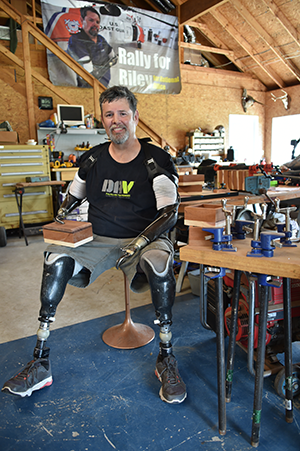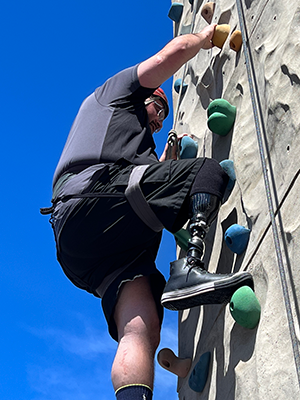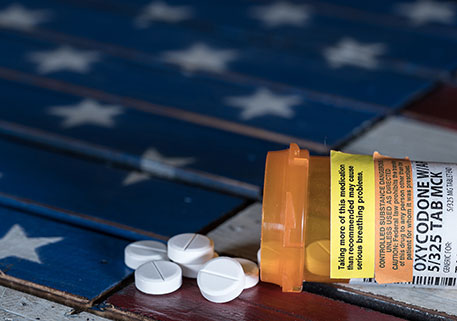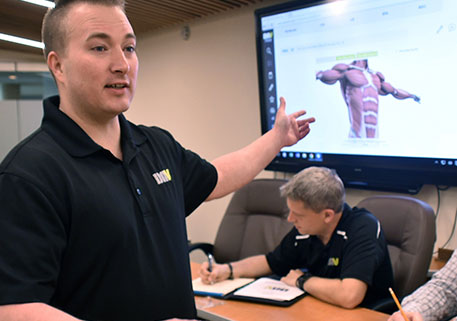
When Army and Coast Guard veteran Dave Riley was prescribed fentanyl patches, the doctor joked that he might one day have to testify in court on the doctor’s behalf.
It was the late 1990s and Riley—who would go on to serve as DAV’s national commander—had just lost all of his limbs due to a bacterial infection. Left in extreme pain, he was a candidate for fentanyl, a powerful opioid about 100 times more potent than morphine.
Over the next 20 years, Riley rode a nightmare rollercoaster as the medical community embraced opioids as a miracle pain treatment, only to reverse course as it witnessed the dangers of the addictive drugs. Two of Riley’s doctors would be shut down by law enforcement, and he did, in fact, have to testify in court. Meanwhile, he was terrified of not having his pain properly treated.
“I wish they’d known more,” Riley said of his doctors. “But I guess it was an education for them and for me.”
Many veterans are familiar with the struggle. Affecting up to 70% of veterans, chronic pain is the leading cause of disability among those who served, and severe pain is 40% more prevalent in veterans than nonveterans.
That put veterans, as Riley said, on the “bleeding edge” of the opioid boom of the ’90s and early aughts. While many veterans benefited from opioids, too many suffered from a sometimes-lethal mix of misinformation, irresponsible prescribing practices and nefarious profiteers.
Much has changed since then. The Department of Veterans Affairs touts less dependence on opioid-based treatment, opting for a more holistic approach to pain. But after decades of relying on opioids, making the change is no easy task.
WITHDRAWAL

When Oscar Olguin arrived at Walter Reed Army Medical Center in late 2004, the amputee ward was full. So the 18-year-old, who had just lost his right leg in a suicide car bomb attack in Iraq, stayed with the traumatic brain injury (TBI) patients.
Limb loss and TBIs were the hallmark injuries of that generation of warfighters, and “pain was the glue among all of them,” said Dr. Robert Kerns, a pain researcher and clinical psychologist who retired from the VA after 36 years. In those early days, “there was no sparing” of prescribing opioids for pain, Kerns said.
Before 9/11, pain had started to be viewed as an undertreated epidemic. By 1998, the VA joined the wider medical community and adopted pain as a “fifth vital sign,” forcing providers to appropriately address patients’ pain. Kerns said it became apparent that health professionals weren’t well trained in pain management, and there were few treatment options, leading to an overreliance on opioids, which were thought to be effective and safe—due in no small part to aggressive and unscrupulous marketing tactics by drug manufacturers.
For veterans like Olguin and Riley, there’s little question that opioids were an appropriate line of defense. The problem was in how those prescriptions were monitored and managed over time.
When Olguin moved from the hospital to on-site temporary lodging, he was given 90-day supplies of opioids OxyContin and methadone, among other prescriptions. It was up to Olguin to manage those prescriptions with little to no monitoring.
He followed the instructions on the pill bottles—three times a day, refill when finished, etc. When the methadone ran out, there was no direction to refill, so Olguin thought he was finished with them. Within a couple of days, he was in Walter Reed’s emergency room for severe vomiting, sweating and shaking.
“You’re going through withdrawals,” the doctors told him.
Olguin said withdrawal was the worst he’d ever felt in his life. It would take him about a month to fully recover. After adjusting to walking with a prosthesis, he worked with doctors to get off of all opioids. Meanwhile, he witnessed fellow service members fall prey to the drugs, even while they recovered inside Walter Reed housing.
In the years that followed, opioid prescriptions for wounded service members increased—starting with military doctors and continuing in the VA. In 2004, around 19% of veterans in VA care received opioid prescriptions. By 2012, that number jumped to 33%.
The following year, as the nation reckoned with an opioid crisis that had claimed the lives of hundreds of thousands of Americans, the VA launched its Opioid Safety Initiative (OSI), marking a major shift in pain management.
A NEW APPROACH

After more than 30 years in the Army, Sheila Pelletier’s body was riddled with pain, starting with her feet and working up to her knees, back and nearly all of her joints. At times, the pain has left her immobile.
Around 2016, she turned to the VA for help. Her doctor never even suggested opioids. Instead, Pelletier used acupuncture, orthotics and physical therapy and received mental health support related to her pain.
“It’s actually changed my life,” Pelletier said. “Because now I’m not dreading the day. I’m actually looking forward to doing things.”
It’s the kind of whole-health, non-opioid approach to pain that the VA says it now prioritizes. According to the VA, from 2012 to 2022, the number of veterans in its care receiving opioid prescriptions fell by 67%—from nearly 875,000 veterans to less than 290,000.
“We realize nowadays that for chronic pain, [opioids] have great limitations in regard to risks, but also … in regard to the lack of benefit over time,” said VA National Program Director for Pain Management Dr. Friedhelm Sandbrink.
The VA’s new approach prioritizes interdisciplinary medicine that includes everything from behavioral therapy and meditation to acupuncture and chiropractic care. Today, every VA facility is required to have a multidisciplinary pain management team. Additionally, more than 60 sites have an eight-week pain management program, and 23 have a program for more complex pain needs.

Kerns said the VA’s commitment to a safer and more effective approach to pain is evident through the Pain Management Collaboratory (PMC), a research partnership between the National Institutes of Health, the Department of Defense and the VA. The PMC currently manages 16 large-scale trials studying nondrug approaches to pain management, including an automated telehealth option that would be widely accessible.
“It really represents the fact that the field is really dramatically moved on and moved away from the use of opioids,” Kerns said.
But it’s a move that comes with new challenges.
STAYING VIGILANT
When Riley’s first pain doctor was shut down, finding care was life or death.
“I was at such high levels (of fentanyl), I wouldn’t have lasted a week (without a) doctor,” Riley said, adding that many doctors didn’t even want to take him on.
Once his second pain doctor was shuttered, Riley was ready to get off the 20-year rollercoaster and worked with doctors to taper off fentanyl. He’s now able to manage his pain without opioids.
But safely tapering long-term users off of opioids remains a challenge for providers, in part because research in outcomes is lacking.
“We finally have some science to guide us, but we still need a lot more,” Kerns said.
What’s clear is that tapering off opioids is a vulnerable time for veterans. Sandbrink pointed to a 2019 VA study that shows an increased risk of overdose death or suicide when patients stop opioids after long-term, high-dose use. A 2022 study further shows that despite a change in opioid prescribing practices, drug overdose death rates increased more than 54% among veterans between 2010 and 2019, with opioids accounting for more than 93% of deaths.
Conversely, some veterans protest not having access to opioids despite having a legitimate need, ultimately degrading their quality of life.

“This is why it is so important for us to assess appropriately every patient individually,” Sandbrink said. “We want to communicate with the veteran that we are really on their side in seeking the best relief of pain, and when we don’t utilize opioids, it’s not because we don’t believe their pain.”
Kerns said another challenge is that many veterans get care through VA-contracted community care providers, which aren’t required to have the same opioid-related training or policies as the VA.
DAV Deputy National Legislative Director Jon Retzer said it’s about finding the balance between protecting against the risks and ensuring veterans get the quality pain management they need and earned—wherever they get their care.
“Chronic pain is a life-altering condition for many veterans, and each patient deserves individualized treatment that works best for them,” Retzer said. “That’s why the VA must continue to lead the charge on best practices and oversight and invest in research. While we have a much better understanding of pain management than we did 25 years ago, we must remain vigilant to avoid letting any veteran fall through the cracks.”






